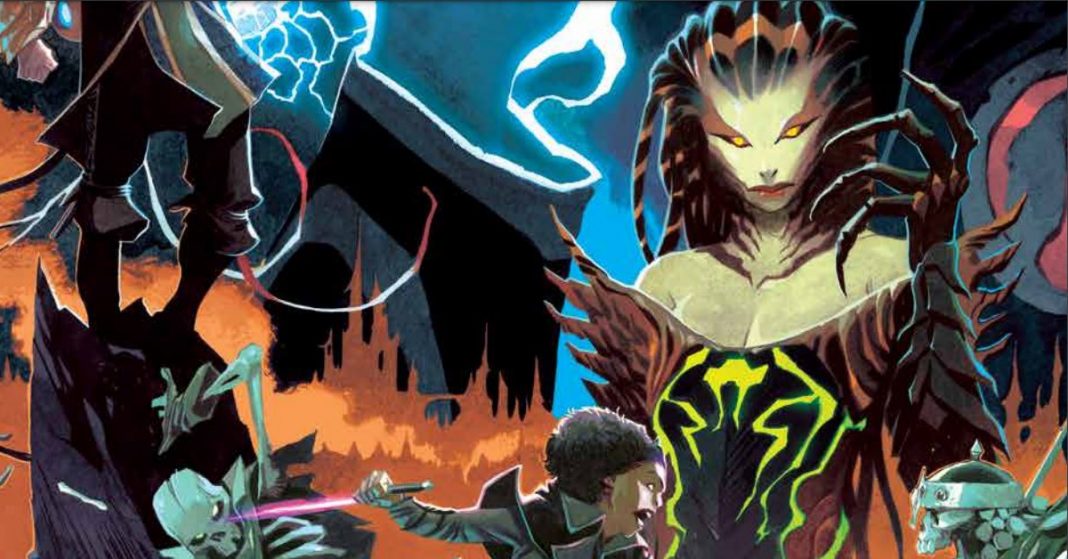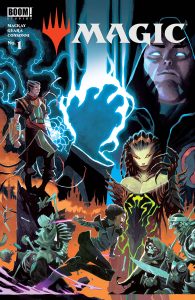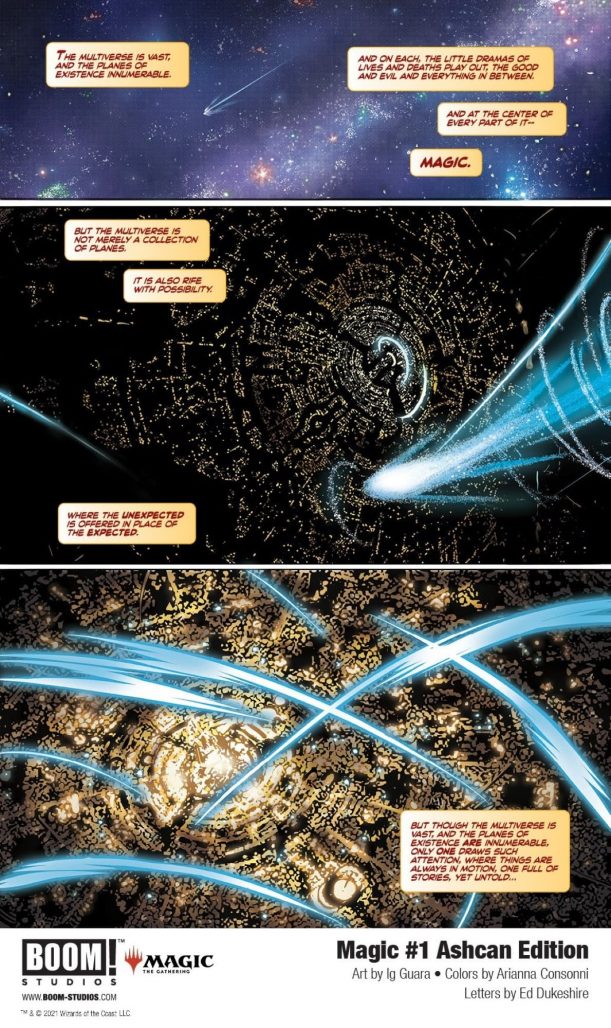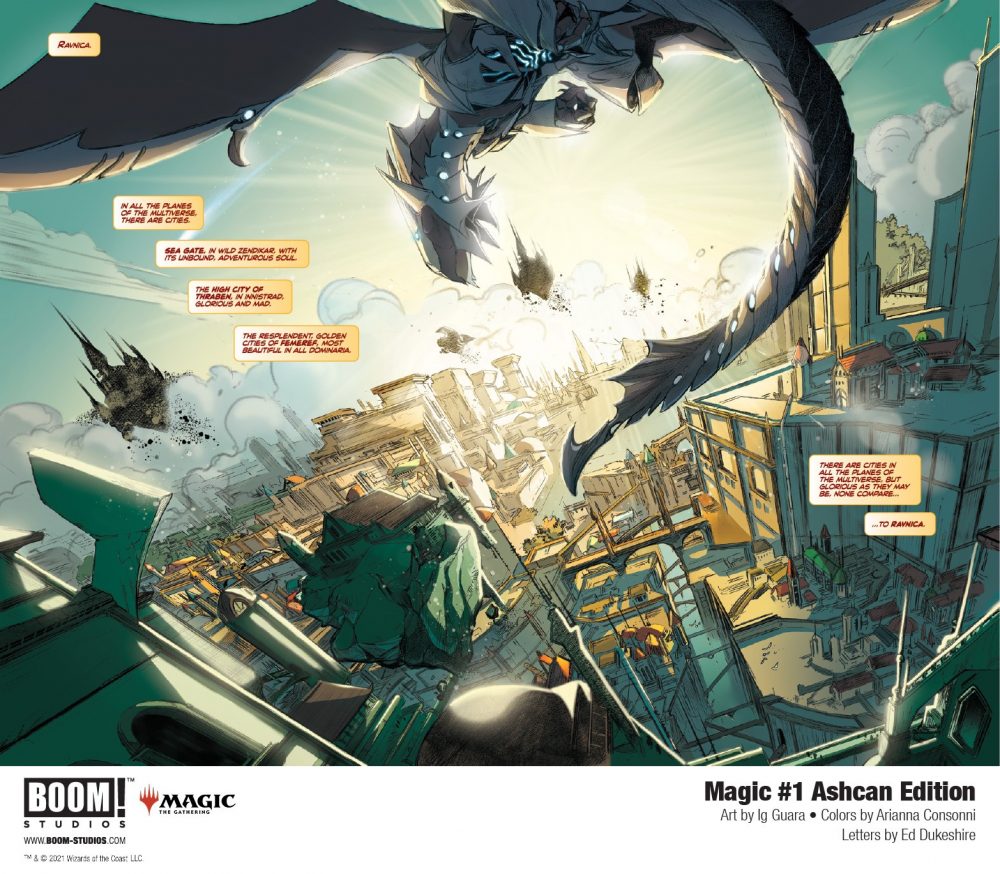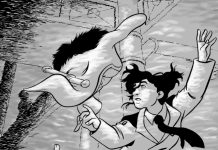Magic #1
Writer: Jed MacKay
Artist: Ig Guara
Color Artist: Arianna Consonni of Arancia Studios
Letterer: Ed Dukeshire
Cover Artists: Matteo Scalera & Moreno Dinisio
Publisher: BOOM! Studios
As is the case with many long-running franchises built on decades of lore and content, getting into Magic: The Gathering can seem a daunting task to the uninitiated. It’s not unlike deciding to jump into X-Men comics without ever having read one. There’s a lot to catch up on to truly get to the heart of it. Jed MacKay and Ig Guara’s new Magic series, coming fresh off of BOOM’s acquisition of the license, seems to be aware of this and rather than easing readers into its world, it instead goes the route of dropping them from way up high into the chaos, but not without helping them build their wings along the way.
Magic #1 feels like opening an official lore or guide book on the multiverse of story that is the card game. It follows a group of guild masters and Planeswalkers (the thematic or card expansion identities players assume through their decks, and also Magic‘s most powerful beings) as they are suddenly attacked by a band of assassins who seem to be specifically trained to deal with the strengths and weaknesses their targets possess.
In a kind of wink to the mechanics of the card game (subtle though it may be), the attack plays out like the type of elemental showdown MTG is known for. What makes the explosive opening work is that MacKay and Guara do their world building as the action unfolds.
Fans will recognize the main location the story takes place in, Ravnica, a city world that houses a complex society dotted with powerful Planeswalkers who operate from all parts of it, all the way down to the slums where pockets of dark magic create realities entirely their own. MacKay’s script does an excellent job explaining how this place manifests itself on a daily basis, detailing the kinds of beings that make up its social fabric.
In a matter of pages we’re introduced to thieves, ghost-assassins, magewrights, maniacs, and all manner of Planeswalker. It might seem like a massive information dump, but it doesn’t come off as such. Of course, Guara’s illustrations help the script set up the world beautifully with each panel being worthy of individual Magic cards of their own.
The vistas presented early on in the comic give Ravnica a sense of history and culture to it that makes everything feel well lived-in. The amount of detail and color added (courtesy of Arianna Consonni) allows for a rich visual exploration of Ravnica, complete with dark lowlands and hidden corners that only those characters with their feet planted in both the lower and higher classes of the city can ever hope to traverse.
The focus on world-building pays off wonderfully, but it comes a bit at the expense of character development, which is also a criticism that can be levied on the card game itself. That the main plotline starts off with the assassins’ attack means we don’t spend enough time getting to know the Planeswalkers that are in the middle of it. Issue #2 might need to pick up on this so that its world gets equally enticing characters.
This might be more of a personal pet peeve, but I’m always looking out for Magic stories that more intentionally incorporate Magic card collecting within the confines of its expanded universe. The game already uses its cards to tell the story, brief though they may be in the process. Perhaps finding a way to reverse engineer the cards so they can be given more story in prose books and comics would be a worthwhile venture.
Of course, this last observation is irrelevant to the comic MacKay and Guara produced to kick off this new chapter in Magic history. The first issue of the new series does a remarkable job setting up its world. It shows its creators are committed to honoring the storytelling elements of the legendary game without watering down the core elements that make it so popular. It’s the kind of comic that’ll make you either pick up your cards for a quick game or go to the store to buy a few booster packs.


